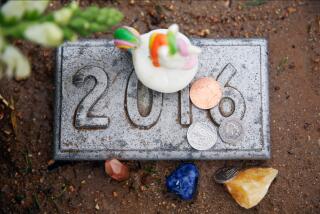Uptick in bicyclist deaths keeps Ghost Bike volunteers busy
Anthony Navarro worked with solemn purpose and a box of tools, stripping the old discarded bicycle of its gear shifts, brakes and chain. He cut his finger, wiped a drop of blood on his pants and kept going.
“It helps me with my anger when I’m doing it,” said Navarro. “It brings me some kind of inner peace.”
On Thanksgiving Day 2011, Navarro’s 6-year-old son, Anthony, was riding his bicycle in front of the family’s Oxnard home when he was struck by a pickup truck.
“The moment I saw him, I knew he was gone,” said Navarro, who reeled under the weight of sudden, unbearable loss.
A few days later, he saw three strangers on his street with a skeletal white bicycle. They said they were with a group called Ghost Bike, which leaves bicycles at the scene of fatal accidents to honor the fallen and remind drivers to slow down and drive more carefully.
Navarro decided several months later that he wanted to join the cause. So he called Long Beach resident Danny Gamboa, one of the Ghost Bikers who had put up his son’s memorial, and volunteered for duty.
The day I met Navarro, stripping old bikes at Gamboa’s apartment, he was about to place his 21st, 22nd and 23rd ghost bikes at accident sites. He had driven down from Oxnard with his wife and four kids, who often accompany him. Unless it’s a late-night job.
“We’ve done them together at 3 in the morning,” said Gamboa, who initially got involved to photograph the operation and bring more attention to the cause.
Gamboa made a short documentary and is working on a longer one, but has also pitched in on 60-plus Ghost Bike placements. He and others in the loosely organized movement have been responding to a dramatic increase in cycling fatalities the last few years.
“Sometimes it’s all I can do to keep up, and keep from crying,” said Ted Rogers, whose blog, bikinginla.com, chronicles the fatalities.
“I started from frustration,” said Rogers, an avid cyclist and West L.A. resident who was disturbed by the lack of news coverage about cycling deaths. He began gathering information from police, cyclists and other sources. He said that in the seven-county Southern California area, he counted 58 cycling fatalities in 2009, with steady annual increases to 89 in 2013.
“The city of Los Angeles had been averaging four to five bicycle deaths per year. Last year, it was 18,” said Rogers, who could only speculate as to why.
Los Angeles has had a dramatic increase in bike lanes, so there may simply be more riders. But as I suggested in a recent column, there’s still a dangerous shortage of protected bikeways, where cyclists don’t have to share space with vehicles. Rogers thinks too many drivers get away with distracted driving, speeding and dangerous lane changes because there isn’t nearly enough enforcement.
Cyclists can be part of the problem, too, especially when they ride at night without lights and helmets.
But Rogers said that by his accounting, 10 of the 18 fatalities in Los Angeles last year were hit-and-run cases. One of his latest posts was about a Huntington Beach cyclist killed last week in a hit-and-run that led to the arrest of a driver on suspicion of drunk driving. On Thursday night, Gamboa and Kat Jarvis placed a Ghost Bike at the scene.
In the city and beyond, the victims are children, young adults, recreational cyclists and commuters who can’t afford cars.
“It could be a guy in a chef’s outfit or a busboy’s uniform … coming home from work at 2 a.m. and he gets hit by a drunk driver,” Rogers said.
In Glendora, a 79-year-old poet named Francisco Alvarez (poesiadelmomento.com) was out for his daily 10-mile ride in late January when an elderly driver plowed into him. Catherine Alvarez, Francisco’s wife, was grateful for the Ghost Bike left at the scene, but police said it was a distraction and delivered it to her home. She showed me the bike, now in the garden where Francisco used to tinker, and wanted me to share its significance with readers. When you spot a ghost bike, she said, it’s a reminder to drive carefully, without distraction, and to share the road.
The Ghost Bike movement began in St. Louis more than a decade ago and has spread to many other cities. You can find out how to donate a bike and learn more at facebook.com/GhostBikesLosAngeles.
Anthony Navarro told me his 6-year-old son was riding on the sidewalk on that horrible day in 2011, but swerved into the road for unknown reasons.
Navarro, an air-conditioning and heater repairman, meticulously spray-painted the old bones of stripped bicycles in Long Beach the day I met him, turning them into grave markers. He chained the first one to a tree near an Albertson’s in Redondo Beach, where a 7-year-old boy was killed in 2011, just before Navarro lost his own son.
“It’s to let the family know they’re not alone,” Navarro said. “That there’s someone who cares and feels their pain.”
More to Read
Start your day right
Sign up for Essential California for news, features and recommendations from the L.A. Times and beyond in your inbox six days a week.
You may occasionally receive promotional content from the Los Angeles Times.







